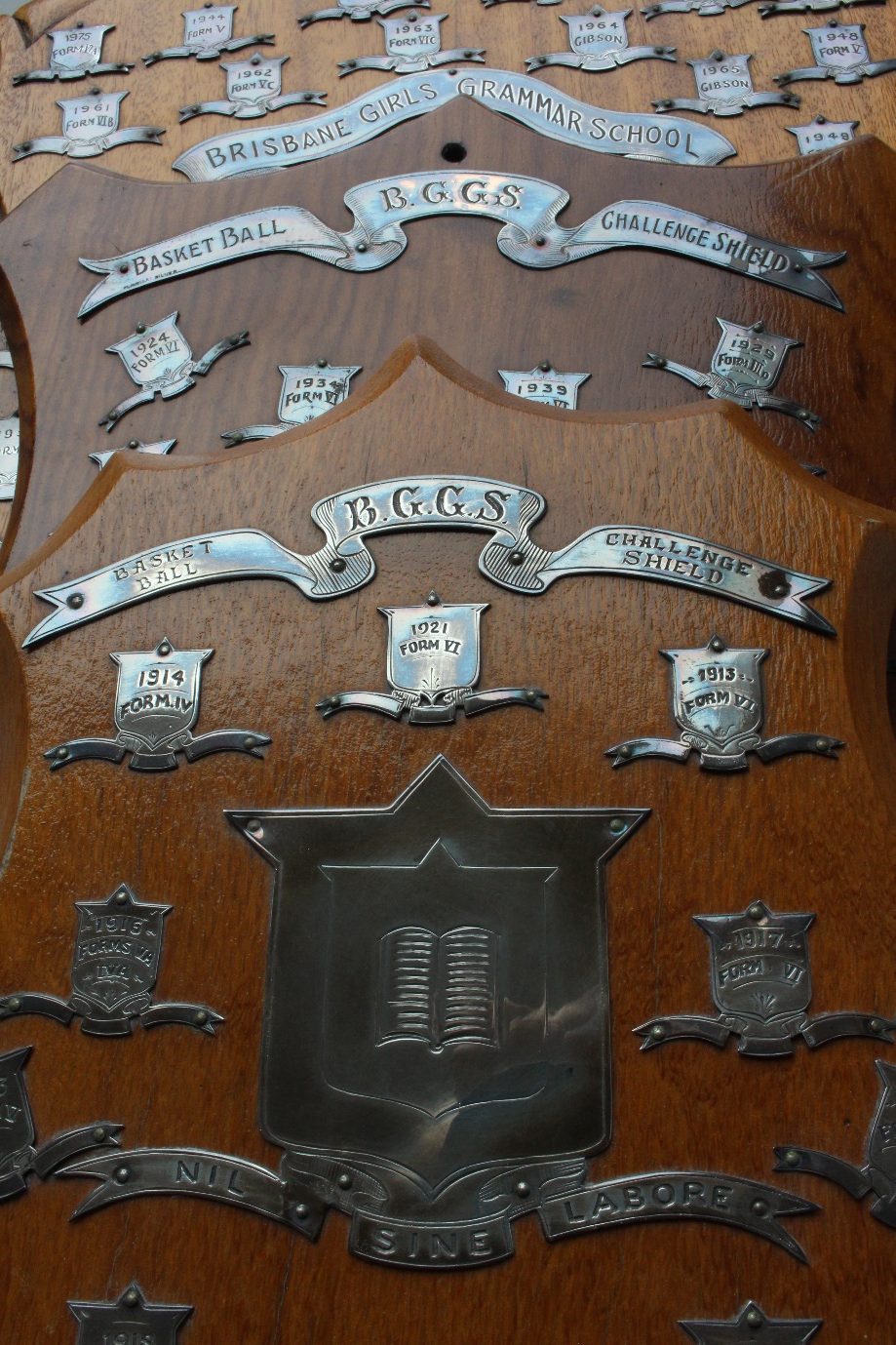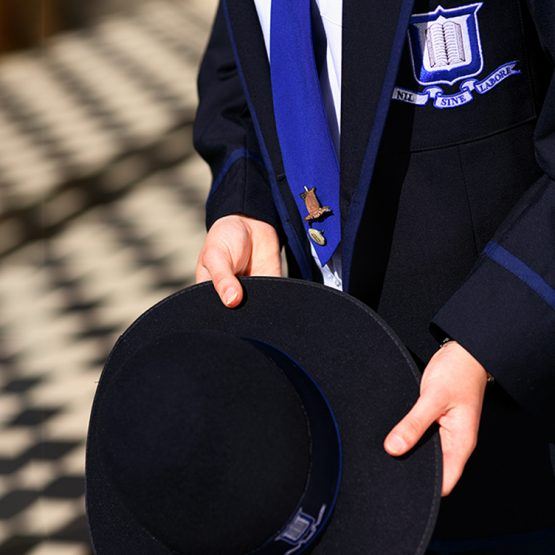As shields go, the three Interform/Interhouse Netball shields are amongst the most exquisite sporting trophies in our treasury. This cluster of shields adorn the wall in the McCrae Grassie Sports Centre foyer next to the impressive Kathleen Lilley Challenge Shield for Physical Culture. They have a long and special history—attesting to a hotly-disputed competition (when weren’t Grammar girls aiming to succeed?), a celebration of achievement, and an interesting chronicle of name changes for the sport itself.

BGGS Basketball Challenge Shield 1913-1923 (Silky Oak)
The Netball shields, made of silky oak (1913-1923), Oregon pine (1924-1943), and English oak (1944-1977), are unique in that the winning form or House was engraved onto a School badge profile which was then attached to the shield. This elegant solution to record winners makes them distinctly Girls Grammar and there is not one other trophy in the collection with this specific design detail.
The Interform Netball Competition was clearly described in the 1928 Sports Club Minute Book:

Sports Club Minutes 1928 p4
Each successful form was chronicled and, as each shield filled, a new shield was created using the same procedure of engraved badge replicas. The first two shields were each labelled ‘BGGS Basket Ball Challenge Shield’ and the most recent shield, simply, ‘Brisbane Girls Grammar School Netball’.

1924-43 BGGS Basketball Challenge Shield (Oregon Pine)

BGGS Netball 1944-1977 (English Oak)
Netball, or women’s ‘Basket Ball’—spelled in this manner and as it was originally known, has been part of the Australian women’s sporting landscape for more than 120 years. The game was adapted from American schoolteacher James Naismith’s five-a-side basketball game. As with many 19th-century activities, women and girls wanted to be athletic but were originally hindered by fashion and social opinion. Netball, as we know it, evolved from women looking for solutions to their restrictions to participation in this new sport by adapting the rules. The first adaptation was made by American sports teacher, Clara Baer. However, importantly for the popularity and dissemination of the game, the rules were codified by Martina Bergman-Osterberg in 1893 and taught at her Physical Education College in England. It was not uncommon for Australian educators to receive their academic qualifications in England and return to Australia, bringing new credentials and ideas. Dorothy Brockway, Physical Education teacher at Girls Grammar from 1913 to 1934, was one of these women. Though Brockway trained at Southport Physical Training College, England, syllabi were similar across these English physical training colleges.
Interschool and Interform (Women’s) Basket Ball appears to have been introduced to Girls Grammar in 1913, during Dorothy Brockway’s first year on staff, although Miss Florence Hunt BSc (London) was listed as coach and umpire. Fortunately, 1913 also saw the introduction of the School Magazine and, subsequently, we have a list of the sporting activities Grammar girls could experience in that year. These included Tennis, (Women’s) Basket Ball, Swimming, Lifesaving, Rowing, Gardening (for boarders), Club-swinging, and Swedish Drill. Referring to Women’s Basket Ball, the 1913 Magazine explains that ‘(t)his game is quite new at school, and at first was taken up in April quite eagerly’. The report continues with a description of the outcomes of the various forms’ competition held in August and September and finishes with ‘(t)he first interform match between the Sixth and the Fourth resulted in a draw, but the Sixth succeeded in winning the final match, thus securing first place in the form matches’ (1913 BGGS Magazine).
From 1913 to 1925, the sport was referred to as ‘Basket Ball’ with many reports, found in the magazines under Form Notes, of different forms’ successes. One of the most iconic images in our archives is Dorothy Hill’s photograph of the 1923 V versus VI Basket Ball Shield match which V Form (Year 11) won.

1923 V v VI Netball Shield competition

1923 Back of above photograph from Dorothy Hill
Confusingly, a report in the 1926 School Magazine refers to the sport as ‘Net Ball’, stating ‘this is the first year net ball has been played’. The sport is then referred to in the School Magazine as Net Ball until 1946. One assumption is there were some rule changes and, subsequently, the sport changed its name. This assumption is supported by another name change in 1947, back to Basket Ball, where captain, Dell Croker (1947) asserts in the School magazine report: ‘this year for the first time all Secondary Schools played Basket Ball instead of Net Ball. This, except for several variations, is very similar to the previous way of playing’ (1947 BGGS December Magazine p35). Or perhaps the 1920s’ Grammar community were influenced by their English counterparts where Women’s Basketball was referred to as Netball.
Intramural Netball games featured across Girls Grammar’s sporting history giving bragging rights to victorious classes. The 1938 V Form Notes written, I presume, by the Form captain, Ethel Holyoake (1939), who became Head Girl the following year, stated that 1938 had been ‘the most pleasant of their school years. We have combined work, play and good companionship; and although sport has dominated, work has not been entirely forgotten …To our triple win in Inter-form Athletics, Tennis and Net Ball—due in large measure to support from Commercial V, we hope soon to add the Swimming Cup—if a significant number enter for the Novelty Race!’ (1938 BGGS Dec Magazine p18).

1938 V Form Interform Netball winners.
The 1947 winners, IVC (Year 10), were most creative in writing their Form Notes for the year and managed to include their Basket Ball win.

1947 IVC Magazine Report
Highly successful forms also dominated the competition over several years as seen from 1958 to 1960, where the winning class, IVB, essentially had the same core group of girls from Years 10 (IVB) to 12 (VIB), led by Joan Bruce (Simpson, 1960), who became the School’s 1960 Basket Ball captain. Joan remembers Basket Ball as her great love at Girls Grammar with lifelong friendships created on the court.

1960 VIB Netball team. Left to right—Dorothy Rutter, Lynsey Speight, Beverley White, Joan Simpson, Miss Macmillan, and Robyn Holt

1960 VIB discuss tactics as the School watches. Left to right—Helen George, Robyn Holt, Val Skerman, Beverley White, Dorothy Rutter, Lynsey Speight, and Joan Simpson
The House system was introduced In 1964, with Gibson being the first House to win the Netball Shield, before dominating for the next two years. There were Senior and Junior teams in each House built of mixed age groups.

1967 Gibson Junior and Senior Basketball teams
Julie Dickinson (1970), 1970 Netball captain and Head Girl remembers: ‘My now vague (sadly) recollection of Interhouse Netball was that it was fun. A motley crew of England House netballers with a range of skill levels was cobbled together by the House Captain and somehow with little practice, we’d coalesce into a functioning team … The best part for me—playing a competitive sport I loved, in a team with girls from across year levels I probably wouldn’t otherwise have got to know’ (Email 14.03.24).

1969 England Senior Netball Team. Back row—Mary Salter, Margaret Richards, Tania Gay, Valerie Richards. Seated—Victoria Gehrmann, Christine Haigh, Julie Dickinson
The competition continued in various formats until 1977 when Head Girls, Lillain Duncombe (Fielding, 1977) and Lynden Stone (Permezel, 1977), noted in their School Magazine report: ‘July 6th was devoted to a new concept in interform sport—an intramural Sports Day. Everybody had a game of something—tennis, netball, volleyball, vigoro or table tennis’ (1977 BGGS Magazine). Houses returned in 1980; however, the Netball Shield was not reinstated as a separate prize, although House Netball competitions were played erratically across the ensuing years.
There have always been differing opinions on intramural sport. It is a positive entrée into a new activity: it allows girls who miss out on School representative teams to play their chosen sport; it provides a fun and happy House activity that allows older students to shoulder responsibility with leadership, coaching and officiating duties; it can be a selection tool; it provides healthy, robust activity away from screen time in a School day. Whatever a person’s belief, in the case of Netball at Girls Grammar, it is a sport that has weathered the vicissitudes of time, carries a significant historical presence, and warrants a permanent place at the Interhouse competition table.

The three Netball Shields (detail)
These elegant shields bear witness to Girls Grammar’s remarkable 111-year Intramural Netball history, pre-empting even the establishment of the All-Australian Women’s Basketball Association (Netball Australia). They represent and celebrate competition, comradery, and challenge and, hopefully, create happy memories for those Girls Grammar athletes who graced our netball courts.
Pauline Harvey-Short (Harvey, 1971)
Manager, School History and Culture
References
Aydon, R Email correspondence 11.03.24
BGGS Annual Reports 1913
BGGS Magazines 1913-1977
Bruce, J Email correspondence 11.03.24
Dickinson, J Email correspondence 14.03.24
Rees, C Email correspondence 13.03.24
Sports Club Minute Book 1928-1929.

The Interform/House Netball Shields




